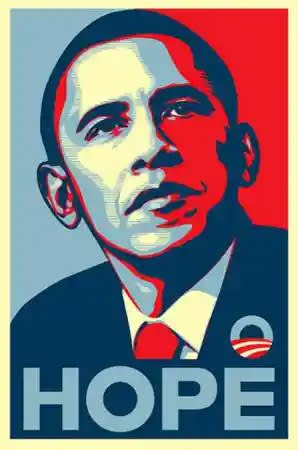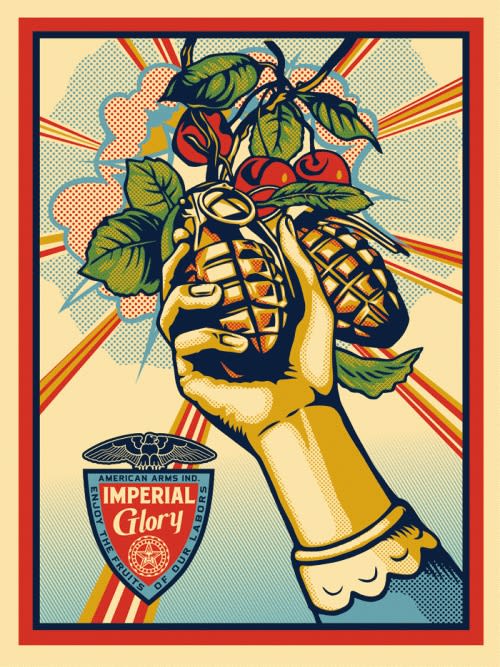Before the Internet became mainstream media and Web 2.0 social channels made content sharing an everyday cultural norm, innovative young artists like Shepard Fairey relied on Word of Mouth advertising to launch “viral” campaigns. Like Pop Artist Keith Haring, who took to Manhattan’s subway stations to garner exposure for his early works, Shepard Fairey employed street tactics to plant seeds of inquiry about the nature of his artistic intentions. In 1989, while a student at the Rhode Island School of Design, Fairey stumbled upon viral success with a sticker he designed and disseminated – bearing the likeness of professional wrestler Andre The Giant.
In typical Pop Art form, the Andre The Giant sticker had just the right lack of explanation to engender healthy intrigue and debate about its meaning and significance. The sticker indicates a bit of graffiti art style and sensibility, revealing that the “Has A Posse” statement has been added to the portrait bearing the wrestler’s name and impressive physical specifications.
In hindsight, for those familiar with Shepard Fairey’s question authority mindset, the statement also carries a healthy dose of relevance. In fact, due to the unexpected enormous success of the sticker campaign, the concept morphed into an ongoing “Obey Giant” campaign – one that likens The Giant to powerful organizations such as the government and military arms of the establishment. The red and black colors of the Obey Giant campaign would become core colors within the style of the Shepard Fairy “brand.”
Art and culture are very undervalued in their ability to promote the ideas of democracy and freedom of expression, which to me is freedom in general.”
—Shepard Fairey
By the time Fairey got to RISD (Rhode Island School of Design), the artist was heavily influenced by the skateboarding and punk rock culture he gravitated to growing up in Charleston, SC in the 1970s and 80s. Shepard Fairey credits his upbringing as part of a subculture that distrusts the establishment as an important aspect of what still fuels his art today. Even as he’s transformed from fringe artist to successful commercial artist, he’s done so with a style that lends itself to brands that seek to be positioned with “an edge.” Of course, living in an age where the Baby Boomer’s original “question authority” culture has pervaded mainstream sensibilities, it’s increasingly difficult for such views to gain traction as true “fringe”.
In 2008, Shepard Fairey’s Hope portrait of candidate Barack Obama elevated the artist to worldwide fame. For the majority of American masses, his rise to fame was “overnight.” Hope became an instant classic, with posters and stickers suddenly appearing everywhere in support of the desire for a new president to replace the unpopular George W. Bush presidency. The portrait captured the promise of a dramatic change in the White House and it was accompanied by two other posters Fairey developed as part of a series. The other two, Change and Vote, were also widely embraced by the Obama presidential campaign.
Fast forward to today and you’ll find that Fairey is still creating Pop Art that questions authority, often coupled paradoxically within framework of a nostalgic Americana style. Recently, Vertu Fine Art acquired two Shepard Fairy prints created in 2012 that are quintessential representations of the artist’s finest works. Both are done in comic book style that conveys the artist’s influence by Pop Artist greats who have come before, most notably Roy Lichtenstein.
Imperial Glory is an intriguing print that packs a punch. This Shepard Fairey work appears to be the love child of a military propaganda poster and an advertisement for hand-picked fruit. Of course, the parents of this work would have to be Lichtenstein and Fairey – with Ben-Day dots and Shepard’s now iconic red rays leading energetically from center to edges. Ensuring that there’s no ambiguity about who’s sponsoring this piece, “American Arms Ind.” appears within the border of the Imperial Glory shield. Fairy created this piece to play lighter in contrast to the accompanying Power.
As any Pop Art collector will discern, Power is a pure channeling of Lichtenstein. This work is a masterful comic book frame demonstrating the ease at which one can wield military might. It’s as if viewing 1950s ad for an aerosol can that’s conveniently employed to rid oneself of pesky enemies! What an enjoyable piece of Contemporary Art – whimsical, nostalgic and heavy simultaneously.
If you’re a Pop Art collector, visit with us at VFA and see these and other newly acquired Shepard Fairey prints. If you’re seeking works by Fairey or any Pop, Op or Abstract Expressionist Artists, feel free to contact us for assistance.







